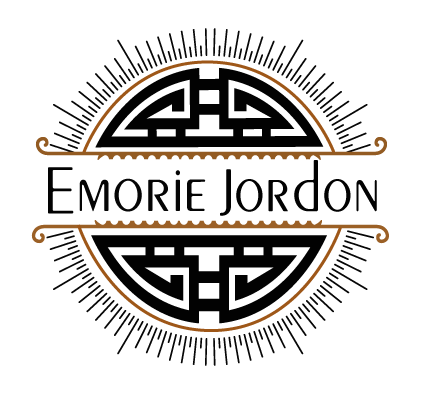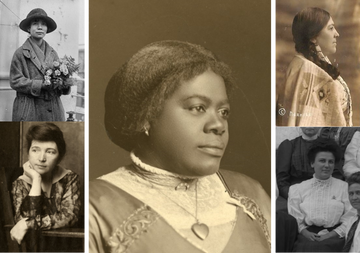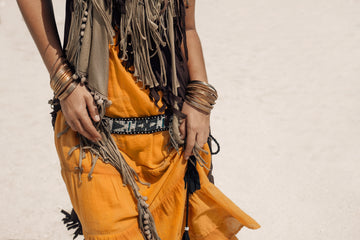Women’s History Month: 5 Powerful Women Who Changed The World

Above all else, what I love about being a woman is our history and proven ability to redefine ourselves. Women’s History Month is a time to acknowledge and honor the various cultures, tactics, and beliefs that went into the fight for women's equality. Regardless of the time period, oppressors, or where we come from, women have always been fearless in the fight to both embody and educate what it truly means to be a woman.
Without further ado, here are 5 powerful women who made their voices heard and their presence felt in the fight for women’s equality!

1.) Marie Louise Bottineau Baldwin
Born in1863 in Pembina, North Dakota, Marie Baldwin was the daughter of J.B Bottineau, a passionate advocate, and lawyer of the Ojibwa/Chippewa Nation in Minnesota and North Dakota. Throughout her education in Minnesota and, later, St. John’s Ladies College in Canada, it was obvious that Baldwin had the same passion for community and advocacy as her father. It was in the 1890s’ that Baldwin and her father made he travel to Washington D.C in hopes of defending the treaty rights of their Native community. This would soon garner the attention of President Theodore Roosevelt, who was eager to appoint Marie as a clerk to the Office of Indian Affairs; this would make her the first Native American to hold a federal position! Despite initially supporting the assimilation of Native Americans into white culture, Baldwin grew to not only embrace her heritage but also to be vocal and fearless in getting the world to do the same. She was unapologetic of her culture, as she wore her tribal dress and braids for her federal employment ID photo, and, in 1911, took this expression a step further by becoming a spokesperson for Native women and the suffrage movement. She was one of few key suffragists that met with President Wilson (1914) to educate and encourage his support of women’s voting rights.
2.) Mary McLeod Bethune
Born in 1875 as the daughter of two former slaves, Mary Jane Mcleod Bethune would become one of the world's most notable civil and women’s rights leaders as well as a presidential advisor. Bethune was known for her efforts to educate African Americans after the war, and this passion for knowledge and community would eventually lead her to open her very own boarding school, Daytona Beach Literary and Industrial School for Training Negro Girls, which would later merge with the (all-male) Cookman Institute to become Bethune-Cookman College. It was in 1936 that President Franklin Roosevelt gave her the title of director of Negro Affairs of the National Youth Administration, making her the highest-ranking African American woman in government at the time. Bethune not only paved the way for other black civil rights activists and intellectuals but also for black women in predominantly white and male spaces. As a member of the advisory board in 1942, Bethune founded the Women’s Army Corps and went on to make sure of its racial integration.

3.) Margaret Sanger
Margaret Sanger turned the world upside down when she founded the birth control movement, became a notable figure in the fight for women's reproductive rights, and started the company we know today as Planned Parenthood. Born in 1879 in Corning, NY, Sanger’s ambition was greatly influenced by the poverty she experienced in her childhood however it would be the death of her 50-year-old mother that lit a fire in her heart. She knew that her mothers' death was due to the physical complications of surviving eleven pregnancies, and, for this reason, it remained a core belief of hers that the high poverty rate of women and their lack of control over family size were undeniably intertwined. Sanger faced many setbacks with the law, as proving birth control information was illegal at the time. it was in 1914 that she launched The Women Rebel, a feminist publication that advocated for birth control, and in 1916 that she opened the first birth control clinic in Brownsville, Brooklyn.

4.) Mabel Ping-Hua Lee
By the age of sixteen, Mabel Ping-Hua Lee was already leaving her mark in the women’s suffrage movement and was not only chosen to lead nearly 10,000 people in the New York Sufferage Parade but also to act as Chinese representation when leveling with members of status in the white-suffrage movement. As one of the very few Chinese women in the US at the time, Lee was the first to earn her doctorate. Though she couldn’t vote, Lee continued to use her voice in other ways to fight for justice. Mabel Lee and her mother worked restlessly to raise money for Chinese famine victims, were big helpers at the YMCA, and stayed up to date and well versed in the Chinese Revolution that was happening overseas. Though young, Mabel Lee was able to gain the allies of the white-suffrage movement in support of her fight for both women's rights and rights for the Chinese community. This moment made history when Anna Howard Shaw, president of the National American Women’s Suffrage Association, marched directly to the Chinatown contingent with a banner that read,” NAWSA Catching Up With China.”
5.) Maria Guadalupe Evangelina de Lopez
Education, activist, and translator Maria de Lopez was born in Las Angeles in 1881. After graduating from what we now call UCLA, Maria went on to become an English teacher at Los Angeles High School, and, in time, a translator as well. Lopez was extremely vocal in her local Votes for Women’s Club and achieved the title of president of the College Equal Sufferage League in 1911. With her prior experience in translating, Maria was able to act a key role in the fight to enfranchise the women of California by getting across suffrage materials that would usually not be accessible in Spanish. The first woman in the state to do so, Maria took the stage at a Votes for Women’s Club rally in 1911 and spoke on the topic of women suffrage in Spanish. On October 10, 1911, when the suffrage proposition passed, Lopez was one of few women nominated to serve as a representative in the Sufferage Parade.



